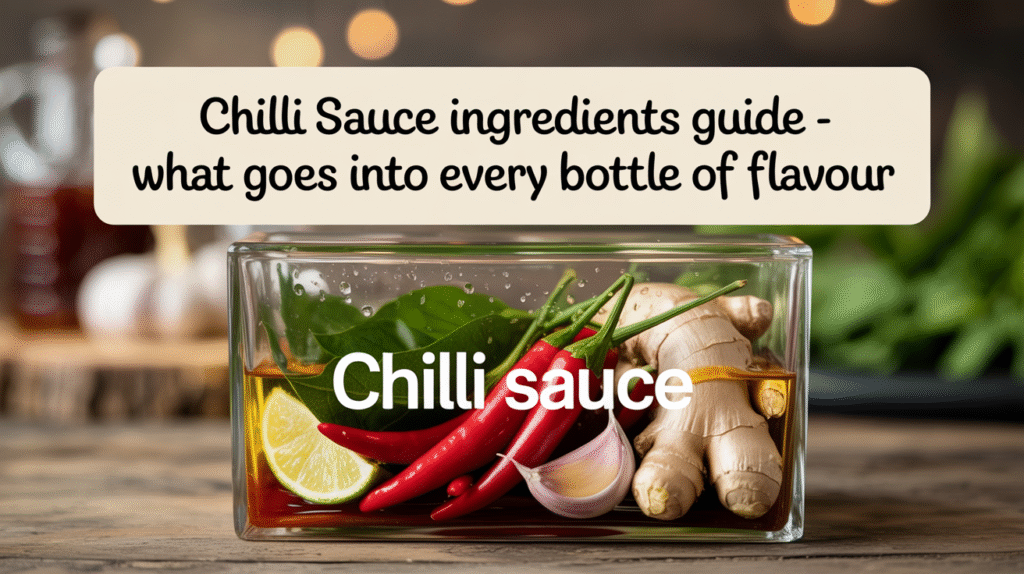Affiliate Disclosure: PantryBrands.co.uk is a participant in the Amazon.co.uk Associates Programme. As an Amazon Associate, we earn from qualifying purchases made through links on this site.
The key ingredients in chilli sauce determine everything from its heat level to its texture and taste. Whether you’re buying it off the shelf or making your own, understanding what goes into a chilli sauce helps you choose the right one for your dish or dietary needs. In this guide, we’ll break down the core ingredients found in most chilli sauces and how they affect flavour and quality.

What Are the Main Ingredients in Chilli Sauce?
Chilli sauces vary around the world, but most include a few essential components. These ingredients form the base, and additional elements may be added depending on regional or brand-specific recipes.
The Essential Ingredients
Most chilli sauces rely on a simple yet powerful mix:
- Chilli peppers: The star ingredient providing heat and flavour.
- Vinegar: Acts as a preservative and adds acidity.
- Salt: Enhances flavour and stabilises the sauce.
- Water or oil: Helps adjust consistency depending on desired texture.
Common Additions
To add depth, sweetness or complexity, these extras are often used:
- Sugar or honey: Balances out strong heat and acidity.
- Garlic or onions: Contribute savoury richness.
- Fruit (like mango or pineapple): Adds sweetness and a tropical twist.
Types of Chillies Used and Their Impact
The type of chilli used has the most significant influence on flavour and heat level. Chillies vary not just in intensity but in taste notes like smokiness, earthiness, and sweetness.
Popular Chillies in Sauces
Here are some commonly used chillies and how they shape the sauce:
- Bird’s Eye Chillies: Found in Thai sauces, very hot and sharp.
- Scotch Bonnet or Habanero: Fruity and fiery, common in Caribbean blends.
- Chipotle: Smoked jalapeño, gives a deep, earthy and smoky taste.
- Cayenne or Red Chilli: Often used in everyday sauces for a bright, moderate heat.
The Role of Vinegar and Acidity
Vinegar does more than just preserve; it defines the sauce’s sharpness and balance.
Why Vinegar Matters
- Acts as a natural preservative to extend shelf life.
- Provides tang and cuts through richness in food.
Types of Vinegar Used
Different types affect flavour:
- White vinegar: Neutral and sharp.
- Rice vinegar: Milder and slightly sweet.
- Apple cider vinegar: Adds complexity and a fruity note.
Sweeteners and Their Balancing Effect
Sweetness tames the intensity of chillies and rounds off flavour. Some sauces are intentionally sweet for dipping and glazing.
Sweetening Ingredients
Look for these on labels or recipes:
- Granulated sugar: Most common and consistent.
- Honey or agave syrup: Adds floral or caramel-like notes.
Balancing Heat and Sweet
- Sweetness can soften sharp heat, making sauces more versatile.
- Essential in sauces like Thai sweet chilli or Asian-inspired glazes.
Garlic, Onions, and Savoury Notes
Savory elements are crucial in giving chilli sauces a fuller flavour that pairs well with meals.
How These Ingredients Help
- Garlic: Adds pungency and depth, often found in Chinese or Indian-style sauces.
- Onions: Give a mellow base and slight sweetness when cooked down.
Fruits and Unique Additions
Some chilli sauces include unusual ingredients that create standout flavours.
Examples of Creative Ingredients
- Mango or Pineapple: Sweet tropical fruit found in Caribbean or fusion sauces.
- Tamarind or Lime Juice: Brings tanginess and pairs well with seafood.
- Mustard or Spices: Found in African and Creole-style sauces.
Preservatives and Thickeners
Not all sauces are created equally. Many commercial brands include stabilisers for shelf life and texture.
Additives You Might See
- Xanthan gum: Used to thicken and stabilise.
- Potassium sorbate or sodium benzoate: Common preservatives.
Natural Alternatives
In homemade or organic versions:
- Thicker textures come from cooked-down vegetables or natural pectin.
- Vinegar and salt do the job of preserving without chemicals.
Understanding Labels and Choosing the Right Sauce
Knowing what’s inside helps you make informed choices, especially if you’re avoiding certain ingredients.
Things to Watch On Labels
- Look for percentage of actual chilli content – higher usually means more flavour.
- Check for sugar levels if you’re cutting back.
Choosing Based on Use
- For cooking: Choose sauces with natural, minimal ingredients.
- For dipping: A sweeter sauce with garlic and fruit might work best.
FAQs About Chilli Sauce Ingredients
Here are some questions and answers about what goes into chilli sauce and why those ingredients matter.
What is the main ingredient in chilli sauce?
The primary ingredient is chilli peppers, supported by vinegar, salt, and sometimes sugar or garlic to create a balanced sauce.
Why do some chilli sauces taste sweet?
They often include added sugar, honey or fruit to balance out the heat and acidity, especially in dipping or Thai-style sauces.
Are all chilli sauces vinegar-based?
Most are, but some, especially in Indian or African cuisines, may use lemon juice, tamarind or fermentation instead of vinegar.
What makes a chilli sauce shelf-stable?
Vinegar, salt, and sometimes preservatives like sodium benzoate help maintain freshness without refrigeration.
Can I make chilli sauce without sugar?
Yes, but the taste will be sharper and hotter. You can use fruit purée or leave out sweeteners entirely if preferred.
